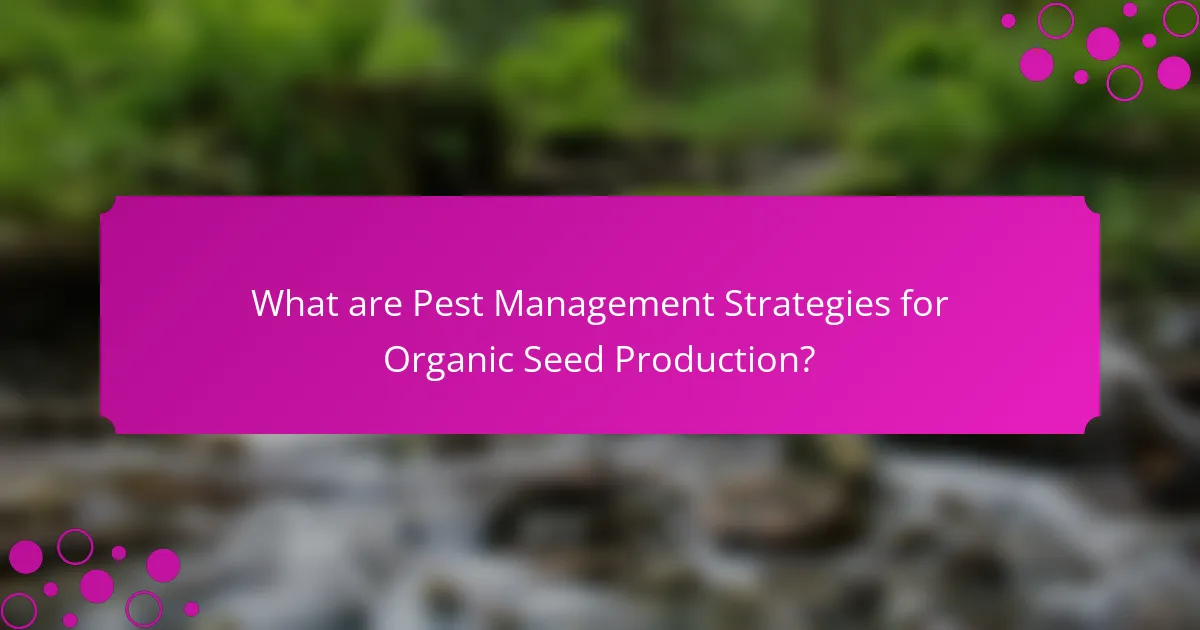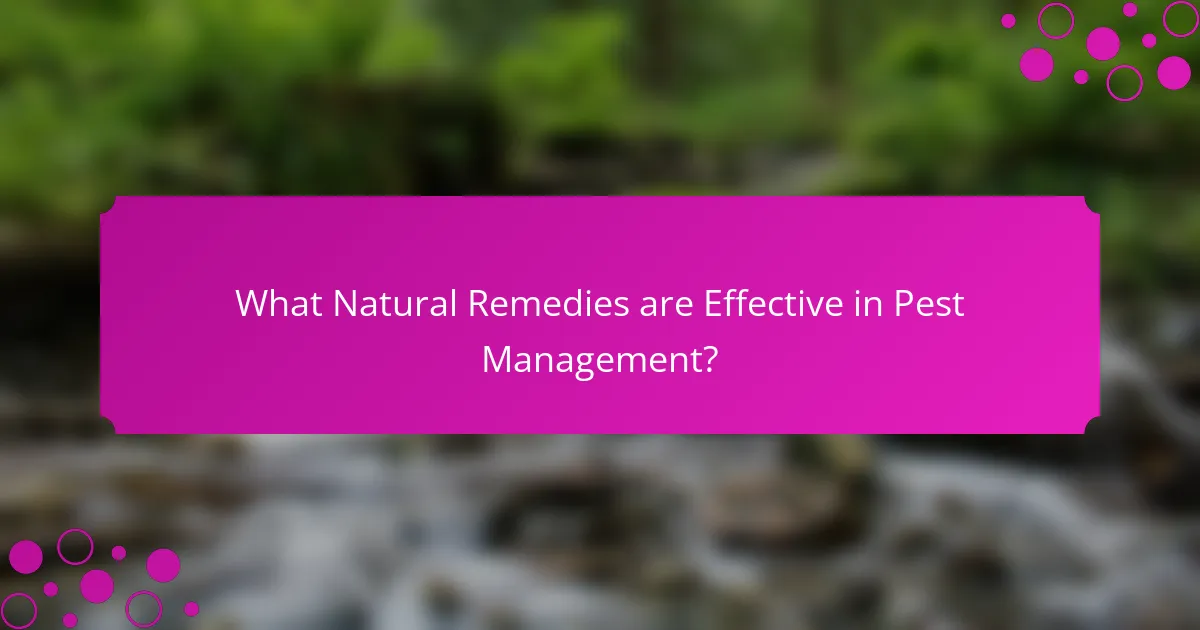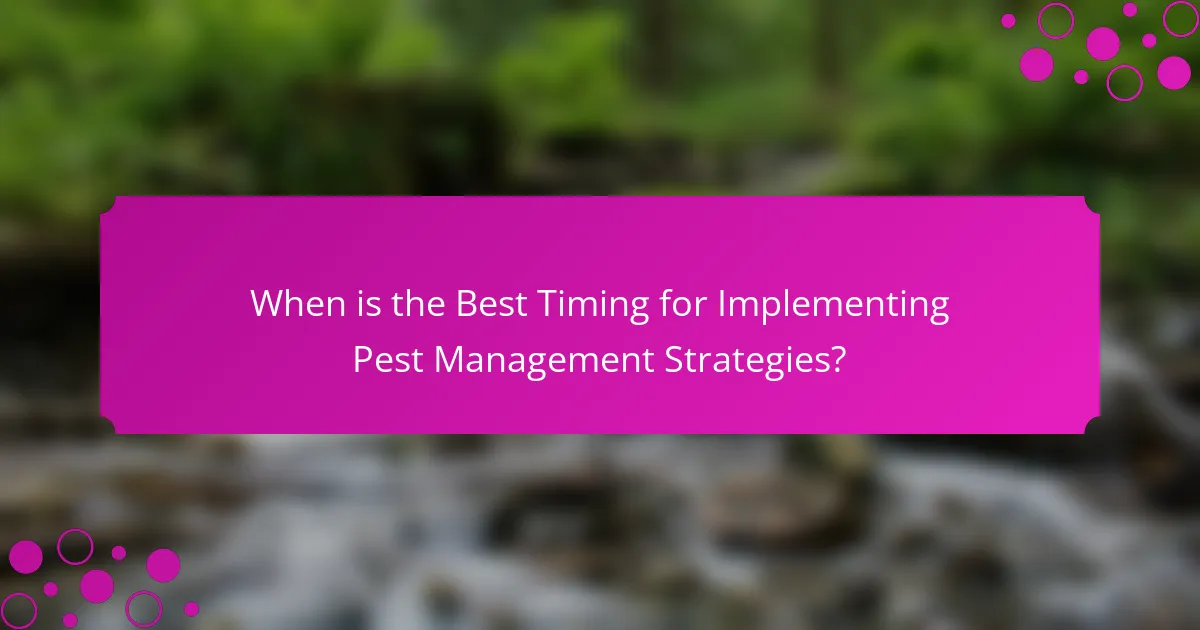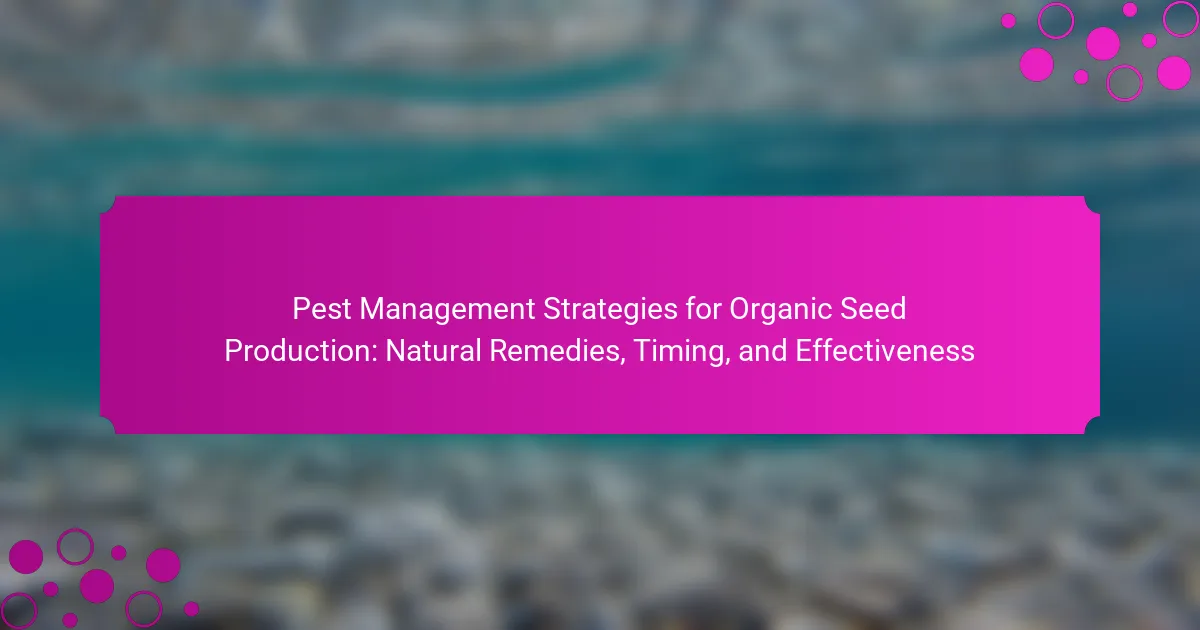Pest management strategies for organic seed production focus on maintaining crop health while minimizing pest damage. Key strategies include cultural practices such as crop rotation and pest-resistant varieties, biological control using natural predators like ladybugs, and mechanical methods involving physical barriers. Natural remedies, including neem oil, diatomaceous earth, and garlic spray, effectively reduce pest populations without harming beneficial insects. Timing is crucial, with early intervention and monitoring aligning with pest life cycles to enhance effectiveness. Integrated Pest Management (IPM) combines these approaches to optimize pest control and support higher yields in organic seed production.

What are Pest Management Strategies for Organic Seed Production?
Pest management strategies for organic seed production include cultural practices, biological control, and mechanical methods. Cultural practices involve crop rotation and selecting pest-resistant varieties. These practices help disrupt pest life cycles and reduce populations. Biological control utilizes natural predators or parasitoids to manage pests. For example, releasing ladybugs can control aphid populations. Mechanical methods involve physical barriers like row covers or traps. These methods prevent pests from accessing plants. Integrated Pest Management (IPM) combines these strategies for effective results. Research shows that IPM can reduce pest damage while maintaining organic integrity.
How do these strategies differ from conventional pest management?
Organic pest management strategies differ from conventional methods primarily in their approach to pest control. Organic strategies emphasize natural remedies and ecological balance. They prioritize the use of beneficial organisms and non-toxic substances. In contrast, conventional pest management often relies on synthetic pesticides and chemicals. Organic methods focus on prevention and habitat management rather than reactive measures. Research indicates that organic practices can enhance biodiversity and soil health. Studies have shown that organic pest management can reduce chemical runoff into ecosystems. These differences highlight a fundamental shift towards sustainability in pest control practices.
What are the key principles of organic pest management?
The key principles of organic pest management include prevention, monitoring, and control. Prevention involves creating a healthy ecosystem to minimize pest problems. This can be achieved through crop rotation, soil health improvement, and selecting pest-resistant plant varieties. Monitoring entails regularly inspecting plants for signs of pests and diseases. This helps in identifying issues early on. Control methods focus on using natural predators, biopesticides, and organic-approved substances. These methods are designed to reduce pest populations without harming beneficial organisms. Research indicates that these practices effectively maintain pest levels below economic thresholds while promoting environmental sustainability.
Why is it important to consider pest management in seed production?
Pest management is crucial in seed production to ensure high-quality yields. Effective pest control prevents damage to seeds, which can affect germination and growth. Healthy seeds lead to robust plants, maximizing crop potential. Inadequate pest management can result in significant economic losses. According to the USDA, pest-related losses in agriculture can exceed 30% if not managed properly. Implementing pest management strategies reduces the risk of infestations and promotes sustainable farming practices. This approach supports the overall health of the ecosystem and enhances biodiversity.
What are the common pests affecting organic seed production?
Common pests affecting organic seed production include aphids, thrips, and spider mites. Aphids can transmit viruses and weaken plants by feeding on sap. Thrips damage leaves and flowers, leading to reduced seed quality. Spider mites thrive in hot, dry conditions and cause stippling on leaves. Additionally, caterpillars and beetles can also infest seed crops, causing significant harm. These pests are prevalent in various organic farming systems, impacting yield and seed viability. Effective pest management strategies are essential to mitigate their effects.
How do these pests impact seed quality and yield?
Pests significantly reduce seed quality and yield. They damage seeds by feeding on them or transmitting diseases. This damage can lead to lower germination rates. Additionally, pests can affect the overall health of the plants. Healthy plants produce more seeds with better quality. According to the USDA, pest infestations can reduce yields by 10-30% in affected crops. Effective pest management is essential to maintain seed quality and maximize yield.
What are the signs of pest infestation in organic seeds?
Signs of pest infestation in organic seeds include visible damage, such as holes or chew marks. Discoloration or mold on seeds can indicate pest presence. Additionally, a musty odor may suggest infestation. Finding dead insects or frass (insect droppings) near the seeds is another sign. Seeds may also exhibit abnormal growth or poor germination rates. Monitoring these signs is crucial for effective pest management. Regular inspections can help detect issues early.

What Natural Remedies are Effective in Pest Management?
Natural remedies effective in pest management include neem oil, diatomaceous earth, and garlic spray. Neem oil disrupts the life cycle of pests and is derived from the seeds of the neem tree. Diatomaceous earth works by dehydrating insects, making it a physical barrier against pests. Garlic spray repels insects due to its strong odor and can deter various pests. Research indicates that these remedies can reduce pest populations significantly while being safe for beneficial insects. Studies have shown neem oil can reduce aphid populations by up to 90% in treated areas. Additionally, diatomaceous earth has been found effective against soft-bodied insects like slugs and aphids.
How do natural remedies compare to chemical pesticides?
Natural remedies differ significantly from chemical pesticides in their composition and impact on the environment. Natural remedies are derived from plant, animal, or mineral sources. They tend to be less toxic to non-target organisms, including beneficial insects and humans. Chemical pesticides, on the other hand, are synthetic compounds designed to kill pests effectively. They often have a broader spectrum of activity but can harm beneficial organisms and lead to pesticide resistance.
Research indicates that natural remedies may require more frequent application and may not be as immediately effective as chemical pesticides. For example, studies show that neem oil, a common natural remedy, can reduce pest populations but often takes longer to show results compared to synthetic insecticides. Additionally, while chemical pesticides can provide quick knockdown of pests, they may also lead to environmental concerns such as soil and water contamination.
Overall, natural remedies offer a more eco-friendly approach, although they may require more management and monitoring to achieve desired pest control results.
What are the most commonly used natural remedies for pest control?
The most commonly used natural remedies for pest control include neem oil, diatomaceous earth, and garlic spray. Neem oil is derived from the seeds of the neem tree and disrupts the life cycle of pests. Diatomaceous earth is a fine powder made from fossilized algae that damages the exoskeletons of insects. Garlic spray repels pests due to its strong odor and sulfur compounds. Other remedies include essential oils like peppermint and tea tree oil, which deter various insects. These remedies are favored in organic farming for their effectiveness and low toxicity.
How can beneficial insects aid in pest management?
Beneficial insects aid in pest management by naturally controlling pest populations. They include predators, parasitoids, and pollinators that target harmful insects. For example, ladybugs consume aphids, reducing their numbers significantly. Parasitic wasps lay eggs in pest larvae, ultimately controlling their populations. Research shows that introducing beneficial insects can decrease pest damage by up to 90% in crops. Additionally, these insects promote biodiversity and improve soil health, creating a balanced ecosystem. Their presence can reduce the need for chemical pesticides, aligning with organic farming practices. Thus, beneficial insects are crucial for sustainable pest management in organic seed production.
What are the benefits of using natural remedies?
Natural remedies offer various benefits for pest management in organic seed production. They are often safer for the environment and non-toxic to beneficial insects. Natural remedies can enhance soil health, promoting a balanced ecosystem. They are usually more cost-effective compared to synthetic pesticides. Additionally, these remedies can reduce the risk of pest resistance. Studies indicate that natural solutions like neem oil and diatomaceous earth can effectively control pests. Research has shown that organic methods can improve crop yield and quality. The use of natural remedies aligns with sustainable farming practices, supporting biodiversity.
How do natural remedies contribute to soil health?
Natural remedies contribute to soil health by enhancing nutrient availability and promoting microbial diversity. They often include organic materials such as compost, which improves soil structure and fertility. Natural remedies like plant extracts can suppress soil-borne pathogens, reducing the need for chemical fertilizers. Additionally, these remedies improve water retention in the soil, benefiting plant growth. Research shows that organic amendments can increase beneficial microbial populations, which play a crucial role in nutrient cycling. For example, studies indicate that compost application can raise soil organic matter content by up to 30%. This improvement in soil health leads to more resilient agricultural systems.
What are the environmental impacts of using natural remedies?
Using natural remedies generally has positive environmental impacts. They often reduce reliance on synthetic chemicals. This leads to less chemical runoff into water sources. Natural remedies can enhance biodiversity in agricultural ecosystems. They support beneficial insects and pollinators. Additionally, many natural remedies are biodegradable. This minimizes long-term pollution in the soil and water. Research indicates that organic farming methods, including natural remedies, can improve soil health. Healthier soil contributes to better crop resilience and sustainability.

When is the Best Timing for Implementing Pest Management Strategies?
The best timing for implementing pest management strategies is during the early stages of crop development. Early intervention helps prevent pest populations from becoming established. Monitoring pest activity is crucial from planting through the growing season. Timing should align with pest life cycles for maximum effectiveness. For instance, targeting pests during their egg or larval stages can reduce damage significantly. Additionally, seasonal weather patterns can influence pest emergence. Implementing strategies in response to these patterns enhances control measures. Research indicates that proactive management can lead to higher yields in organic seed production.
How does timing affect the effectiveness of pest management strategies?
Timing significantly impacts the effectiveness of pest management strategies. Implementing strategies at the right time can enhance their efficacy against pest populations. For example, applying treatments during specific life stages of pests, such as larvae or adults, increases the likelihood of success. Research shows that targeting pests during their peak activity periods leads to better control outcomes. Additionally, seasonal timing aligns interventions with pest emergence, ensuring that management efforts are proactive rather than reactive. Timing also influences the compatibility of natural remedies with environmental conditions, maximizing their effectiveness. Overall, strategic timing is crucial for optimizing pest management in organic seed production.
What are the critical periods for pest management in seed production?
The critical periods for pest management in seed production are pre-planting, planting, and early growth stages. During pre-planting, it is essential to manage pests in the soil and surrounding environment. This includes monitoring for pests that may affect seed viability. The planting stage requires vigilance as seedlings are vulnerable to pest attacks. Early growth stages are crucial because young plants are often more susceptible to pests. Studies show that effective pest management during these periods can significantly reduce crop damage and increase yields. For instance, research indicates that timely interventions can decrease pest populations by up to 70%.
How can seasonal changes influence pest activity?
Seasonal changes significantly influence pest activity by altering their life cycles and behaviors. Temperature fluctuations affect reproduction rates, with warmer seasons typically leading to increased pest populations. For example, studies show that higher temperatures can accelerate the development of insects, resulting in more generations per season. Additionally, seasonal humidity impacts pest survival and feeding habits. Pests may become more active during wet seasons, seeking food and breeding opportunities. Conversely, cold temperatures can reduce pest numbers by slowing their metabolism and limiting their activity. This cyclical pattern highlights the importance of monitoring seasonal changes for effective pest management in organic seed production.
What are the best practices for monitoring pest populations?
The best practices for monitoring pest populations include regular field scouting and utilizing traps. Field scouting involves inspecting plants for visible signs of pests and damage. This practice should occur at consistent intervals, ideally weekly. Traps can provide quantitative data on pest presence and population levels. Sticky traps are effective for monitoring flying insects, while pitfall traps can capture ground-dwelling pests.
Additionally, using economic thresholds helps determine when pest populations warrant control measures. This approach minimizes unnecessary interventions and promotes sustainable practices. Data collected should be recorded systematically to track trends over time. Implementing these practices enhances pest management effectiveness in organic seed production.
How can farmers effectively track pest life cycles?
Farmers can effectively track pest life cycles by utilizing integrated pest management (IPM) techniques. IPM involves monitoring pest populations through regular field observations and the use of traps. Farmers can also employ phenology calendars to correlate pest activity with environmental conditions. This method helps predict when pests will emerge based on temperature and humidity data. Additionally, using digital tools and mobile applications can enhance data collection and analysis. Research indicates that farmers who implement these strategies can reduce pest damage by up to 30%. Regular education and training on pest identification further support effective tracking and management.
What tools and techniques can assist in pest monitoring?
Pest monitoring can be assisted by various tools and techniques. Common tools include pheromone traps, sticky traps, and visual inspections. Pheromone traps attract specific pests, allowing for population assessment. Sticky traps capture insects, providing evidence of pest presence. Visual inspections involve regularly checking plants for signs of pests or damage. Additionally, remote sensing technology can monitor pest populations using drones or sensors. Data analytics software can analyze pest data for trends. These methods are effective in identifying pest issues early, enabling timely management actions.
What tips can enhance the effectiveness of pest management strategies?
Implementing integrated pest management (IPM) enhances the effectiveness of pest management strategies. IPM combines multiple control methods to minimize pest populations. Regular monitoring of pest levels allows for timely interventions. Utilizing resistant plant varieties reduces susceptibility to pests. Crop rotation disrupts pest life cycles and lowers infestation rates. Employing natural predators can effectively control pest populations. Maintaining proper sanitation practices eliminates potential pest habitats. Lastly, educating farmers about pest identification and management techniques promotes proactive measures. These strategies have been shown to significantly reduce pest damage in organic seed production systems.
Pest management strategies for organic seed production focus on sustainable practices that include cultural methods, biological control, and mechanical techniques. Key principles emphasize prevention, monitoring, and the use of natural remedies such as neem oil and diatomaceous earth to mitigate pest populations while enhancing soil health and biodiversity. The article outlines the differences between organic and conventional pest management, highlights common pests affecting seed quality, and discusses the importance of timely intervention in pest control. Additionally, it covers best practices for monitoring pest activity and the benefits of integrating beneficial insects into pest management systems.
